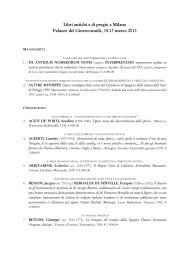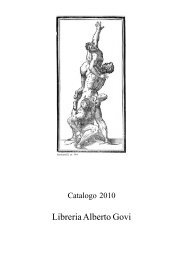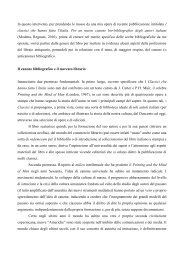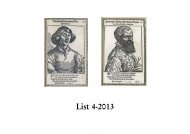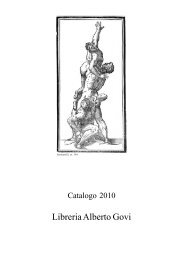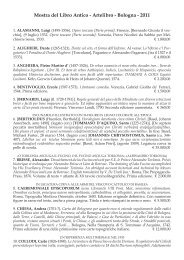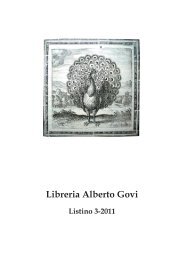16 th century epistolary43) GIOVIO, Paolo (1483-1552). Lettere volgari… raccolte per Messer Lodovico Domenichi. Venezia, GiovanniBattista e Melchiorre Sessa, 1560.122, (2) leaves. With the printer’s device and typographical ornament on the title-page. Modern calf with elabo-rateblind stamped ornaments, marbled endpapers, upper part of the spine and hinges repaired, title-page lightly soiled,but a very fine copy annotated by two old hands, from the library of William Wickham with his printed book-plate.FIRST EDITION published by Lodovico Domenichi. His dedicationto the Genoese nobleman Matteo Montenegro is dated April 1, 1560.Supposed editions of 1548 and 1555 are ghosts. Some of Giovio’s vernacularletters were printed before in two epistolaries: in that of Atanagiprinted in 1554, in that of Ruscelli printed in 1556 (cf. L. Braida,Libri di lettere. Le raccolte epistolari del Cinquecento tra inquitudini religiosee “buon volgare”, Bari, 2009, p. 199).“Ancora più probabile è l’eventualità di interventi sul testodi lettere non preparate in alcun modo dall’autore per la pubblicazione.Un esempio è offerto dall’epistolario di Paolo Giovio, riconosciutodalla critica come uno dei più interessanti del Cinquecento. Si trattadi lettere che conoscono una notevole circolazione manoscritta, e chel’autore manifesta l’intenzione di pubblicare solo nei suoi ultimi anni,senza però effettuare a tale proposito un lavoro concreto. Una sceltaviene data alle stampe nel 1560 da Lodovico Domenichi, uno deipiù noto professionisti dell’editoria veneziana, che interviene sui testida lui stesso selezionati, episodicamente sui contenuti, soprattuttoper ragioni di prudenza e ossequio ai grandi della Chiesa, e sistematicamentesulla compagine linguistica, diminuendo drasticamente lapresenza di forme extratoscane, nell’intento di presentare ai lettori untesto normalizzato. Di conseguenza, la distanza tra la veste originale equella tramandata dalla stampa è grande, e solo la conservazione degliautografi fa sì che possiamo conoscere con precisione l’assetto linguistico-stilisticodato da Giovio alla sua scrittura epistolare” (L. Matt,Teoria e prassi dell’epistolografia italiana tra Cinquecento e primo Seicento,Rome, 2005, p. 86).Paolo Giovio was born in Como. He took a degree in medicineat Pavia, but following his inclination, he devoted himself to thewriting of history. His ready tongue and pen quickly won the favor ofLeo X, who thought that his History of His Own Times was second onlyto Livy. Leo gave him the rank of cavaliere with a pension. HadrianVI made him canon of the cathedral of Como. He was the constantcompanion of Clement VII with rooms in the Vatican. His devotion was rewarded the next year by the bishopric ofNocera. Later, in 1530, we find him accompanying Cardinal Ippolito to Bologna for the coronation of Charles V andin 1533 to Marseilles for the marriage of Catherine dei Medici.Until the fall of Rome his fortunes had prospered. In that catastrophe he lost many of his possessionsincluding some of his manuscripts and retired for a time to the island of Ischia to bewail his calamities. His reputation,too, had begun to wane. Still he continued to find supporters. For twenty years he enjoyed the favor of PompeoColonna and among others to whom he owed benefits and encouragement were the Marquis of Pescara and hiswife, Vittoria Colonna, Ippolito d’Este, Isabella d’Este, the Marquis del Vasto, Giberti, and Ottavio Farnese. Withthe accession of Paul III, however, he fell out of favor at the Vatican. Unsuccessful in his efforts to induce the Popeto make him Bishop of Como and disappointed in his hopes of a cardinal’s hat, he finally retired to Como and thento Florence, where he died December 11, 1552. Probably the occupation that gave Giovio most pleasure in his lateryears was the building and furnishing of the villa on Lake Como, where he collected the portraits of famous men,princes, soldiers, prelates, and scholars (cf. T.C. Price Zimmermann, Paolo Giovio, Princeton, 1995, passim; B. Agosti,Paolo Giovio. Uno storico lombardo nella cultura artistica del Cinquecento, Florence, 2008, passim).Edit 16, CNCE21232; Adams, G-697; B. Gamba, Serie dei testi di lingua, (Venezia, 1839), no. 1431; P. Giovio, Lettere,G.G. Ferrero, ed., (Roma, 1956-58); A. Quondam, Le «carte messaggiere». Retorica e modelli di comunicazione epistolare:per un indice dei libri di lettere del Cinquecento, (Rome, 1981), p. 298; J. Basso, Le genre épistolaire en langue italienne (1538-1662). Répertoire chronologique et analytique, (Roma & Nancy, 1990), I, pp. 199-200. € 850,00- 48 -
a heavily annotated copy44) HORATIUS FLACCUS, Quintus (65-8 B.C.) - LAMBIN, Denis ed. (ca. 1519-1572). Q. Horatius Flaccus.Ex fide, atque auctoritate decem librorum manuscriptorum, opera Dionys. Lambini Monstroliensis emendatus:ab eodemque, commentariis copiosissimis illustratus, nunc primum in lucem editus. Lyon, Jean de Tournes,1561.Two parts in one volume, 4to; (16), 493, (13) pp., (1 blank) l. + 543, (19), (1 blank) l. Printer’s device on the title-pages.The second part contains: Q. Horatii Flacci Sermonum libri quattuor, seu, Satyrarum libri duo. Epistolarum libri duo…With 4 woodcuts in the text depicting ancient coins. Slightly browned (a bit stronger in some places), otherwise afine, genuine copy.The present copy has been heavily annotated in the margins throughout the volume until the end of bookIV of the Odes. Then, with the Epodes, the notes become rarer, to disappear almost entirely in the Satires and Epistles.The glosses are at least of two different hands, one being strictly contemporary, the other a bit later: the latteris responsible for the vast majority of the annotations. On the recto of the first flyleaf a entry of ownership, in anelegant and clear handwriting of the mid sixteenth century, recites: “Sum Pietrantonii Guadagnii.” To this ancientpossessor belong almost certainly the not many notes penned in a rather sharp and controlled handwriting (e.g.,Odes, book II, 18, p. 208v). The other, slightly later hand, is much freer and individualized, to such a point that it isoften difficult or even almost impossible to read. In order to date these later annotations, a note written alongsidethe first two verses of the Ode 2 of the book I is helpful; it reads: “1578 1579 hoc anno in hieme... grando et nix”, witha clear reference to the incipit of the poem (“Iam satis terris nivis atque dirae / Grandinis misit pater, et rubente...“). Taking into consideration this note and also certain intrinsic characteristics of the handwriting, it is possible todate the second hand to the end of the sixteenth century. The frequency and, in some cases, the complexity of theannotations give the impression of a competent and passionate reader, with a profound knowledge of classical literature.He proceeds in his reading in close comparison with other major Greek and Latin authors and with Lambinhimself, whose lectio he sometimes corrects and criticizes with the expression “stulte.”FIRST LAMBIN EDITION OF HORACE, a milestone in the history of that text and of classical philology in general.It was the best edition for a long time, at least until Richard Bentley, due to Lambin’s copious commentary andconsultation of important manuscripts.“Denys Lambin… won a wide reputation by his great editions of Latin authors. The first of these was hisHorace (1561). He had gathered illustrations of his author from every source; and he had collated ten MSS, mainlyin Italy. The text was much improved, while the notes were enriched by the quotation of many parallel passages,and by the tasteful presentment of the spirit and feeling of the Roman poet” (J.E. Sandys, A short history of classicalscholarship from the sixth century B.C. to the present day, Cambridge, 1915, p. 219).“The readers he has foremost in mind are not schoolboys so much as his professional colleagues. The judiciousreading of the text of Horace is the business of Lambin in his general comments as well as in his discussionof manuscript variants. He elucidates Horace’s pronouncements on poetry by very exact, very cogent paraphrase- 49 -
- Page 1 and 2: Catalogue 2013Libreria Alberto Govi
- Page 3 and 4: Catalogue 2013Libreria Alberto Govi
- Page 5 and 6: an hitherto unknown philosophical m
- Page 7 and 8: ustica Lib. X., edited by Giorgio M
- Page 9 and 10: the end is furthermore printed the
- Page 11 and 12: without typographical data, but pro
- Page 13 and 14: Letteratura Italiana”, CXL, 1963,
- Page 15 and 16: as secondary only.The present two e
- Page 17 and 18: position as secretary at the court
- Page 19 and 20: From 1528 he was rector of the newl
- Page 21 and 22: famous personage was in high favor
- Page 23 and 24: Luigi Alamanni and Antonio Brucioli
- Page 25 and 26: In Pincio’s biography of Bernardo
- Page 27 and 28: Tempio della Fama; e così ne trass
- Page 29 and 30: power, and yet to make it possible
- Page 31 and 32: lini, Andrea Alciati, Lilio Gregori
- Page 33 and 34: phy in particular, was presented as
- Page 35 and 36: quale quello che lui auspicava, e l
- Page 37 and 38: After the flight of the Medici from
- Page 39 and 40: to learn from their own experience
- Page 41 and 42: with some manuscript compositions p
- Page 43 and 44: death sentence issued against him o
- Page 45 and 46: the key work to Della Casa’s thou
- Page 47: important ones along with those of
- Page 51 and 52: solitudine (1545), but undoubtedly
- Page 53 and 54: provide less description of patholo
- Page 55 and 56: the most up-to-date scientific ency
- Page 57 and 58: (pp. 4-10) written by the author hi
- Page 59 and 60: successivi alla consapevolezza che
- Page 61 and 62: night [February 22]. Rarely does a
- Page 63 and 64: subjects, including Saint-Gelais’
- Page 65 and 66: Catherine de’ Medici, succeeded o
- Page 67 and 68: losofico ed allegorico delle Metamo
- Page 69 and 70: The act concerning primogeniture is
- Page 71 and 72: are not many in number but who are
- Page 73 and 74: the Camilletta, his first work, Gut
- Page 75 and 76: selig, sich nit allein zu kunst geg
- Page 77 and 78: dle, or low. There are, however, pr
- Page 79 and 80: nity: ‘mercenaries should be done
- Page 81 and 82: colò Sfondrati), to whom the Causa
- Page 83 and 84: close of Semiramis’ career. Ninus
- Page 85 and 86: e contenuti matematici in Henri de
- Page 87 and 88: The first Hungarian dictionary - Cr
- Page 89 and 90: & T. Kovács, Deutschlernen in den
- Page 91 and 92: chitectura’ des Wenzel Dietterlin
- Page 93 and 94: neo-Latin anthology devoted exclusi
- Page 95 and 96: as De la puissance ecclésiastique
- Page 97 and 98: colazione was not eaten first thing
- Page 99 and 100:
advanced both the technical and the
- Page 101 and 102:
di Giorgio Zorzi, ambasciatore in O
- Page 103 and 104:
the Misnah100) MISNAYOT MESUDAR NAS
- Page 105 and 106:
the task of taking part to the nego
- Page 107 and 108:
This is the only iconological work
- Page 109 and 110:
on that occasion, were described an
- Page 111 and 112:
millo Camilliani, Francesco’s son
- Page 113 and 114:
Blanchard, Correggio and Mignard, R
- Page 115 and 116:
di Cicerone d’ottime antiche stam
- Page 117 and 118:
Pietro Aretino125) MAZZUCHELLI, Gio
- Page 119 and 120:
music129) TESTORI, Carlo Giovanni (
- Page 121 and 122:
Vol. VIII (1773): pp. (6), 854 with
- Page 123 and 124:
Di Felice e Gregorio Fontana, 1905,
- Page 125 and 126:
Cicognara, no. 190 (“Nelle quattr
- Page 127 and 128:
mo: fonti, theorie, modelli, 1750-1
- Page 129 and 130:
commentary on the treaty on shabbat
- Page 131 and 132:
poet laureate of Austria, and he le
- Page 133 and 134:
geo-political situation of the regi
- Page 135 and 136:
ope collecting views and pictures o
- Page 137 and 138:
inc.), 100 numbered engraved plates
- Page 139 and 140:
a gift from Emperor Napoléon III t
- Page 141 and 142:
Ardène, no. 123Caprara, no. 103 Tr
- Page 143 and 144:
Speckle, no. 73 Besson, no. 60- 143



